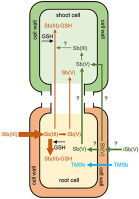Environmental Pollution ( IF 7.6 ) Pub Date : 2017-09-19 , DOI: 10.1016/j.envpol.2017.08.105 Ying Ji , Géraldine Sarret , Rainer Schulin , Susan Tandy

|
Antimony (Sb) is a contaminant of increased prevalence in the environment, but there is little knowledge about the mechanisms of its uptake and translocation within plants. Here, we applied for the synchrotron based X-ray absorption near-edge structure (XANES) spectroscopy to analyze the speciation of Sb in roots and shoots of rye grass (Lolium perenne L. Calibra). Seedlings were grown in nutrient solutions to which either antimonite (Sb(III)), antimonate (Sb(V)) or trimethyl-Sb(V) (TMSb) were added. While exposure to Sb(III) led to around 100 times higher Sb accumulation in the roots than the other two treatments, there was no difference in total Sb in the shoots. Antimony taken up in the Sb(III) treatment was mainly found as Sb-thiol complexes (roots: >76% and shoots: 60%), suggesting detoxification reactions with compounds such as glutathione and phytochelatins. No reduction of accumulated Sb(V) was found in the roots, but half of the translocated Sb was reduced to Sb(III) in the Sb(V) treatment. Antimony accumulated in the TMSb treatment remained in the methylated form in the roots. By synchrotron based XANES spectroscopy, we were able to distinguish the major Sb compounds in plant tissue under different Sb treatments. The results help to understand the translocation and transformation of different Sb species in plants after uptake and provide information for risk assessment of plant growth in Sb contaminated soils.
中文翻译:

使用XANES光谱仪在黑麦草吸收,转运和储存过程中锑(Sb)的命运和化学形态
锑(Sb)是环境中流行度增加的一种污染物,但是对于其在植物体内的吸收和转运机制尚不甚了解。在这里,我们应用了基于同步加速器的X射线吸收近边缘结构(XANES)光谱,以分析黑麦草(黑麦草)的根和茎中的Sb形态L. Calibra)。幼苗在添加了锑矿(Sb(III)),锑酸盐(Sb(V))或三甲基-Sb(V)(TMSb)的营养液中生长。虽然接触Sb(III)导致根部的Sb积累比其他两种处理高约100倍,但枝条中的总Sb没有差异。在Sb(III)处理中吸收的锑主要以Sb-硫醇复合物的形式(根:> 76%,枝芽:60%)发现,表明与谷胱甘肽和植物螯合素等化合物发生了解毒反应。在根部未发现累积的Sb(V)减少,但是在Sb(V)处理中,一半易位的Sb还原为Sb(III)。在TMSb处理中积累的锑在根部保留为甲基化形式。通过基于同步加速器的XANES光谱,我们能够在不同的Sb处理下区分植物组织中的主要Sb化合物。研究结果有助于了解植物吸收后不同Sb物种的转运和转化,并为Sb污染土壤中植物生长的风险评估提供信息。











































 京公网安备 11010802027423号
京公网安备 11010802027423号